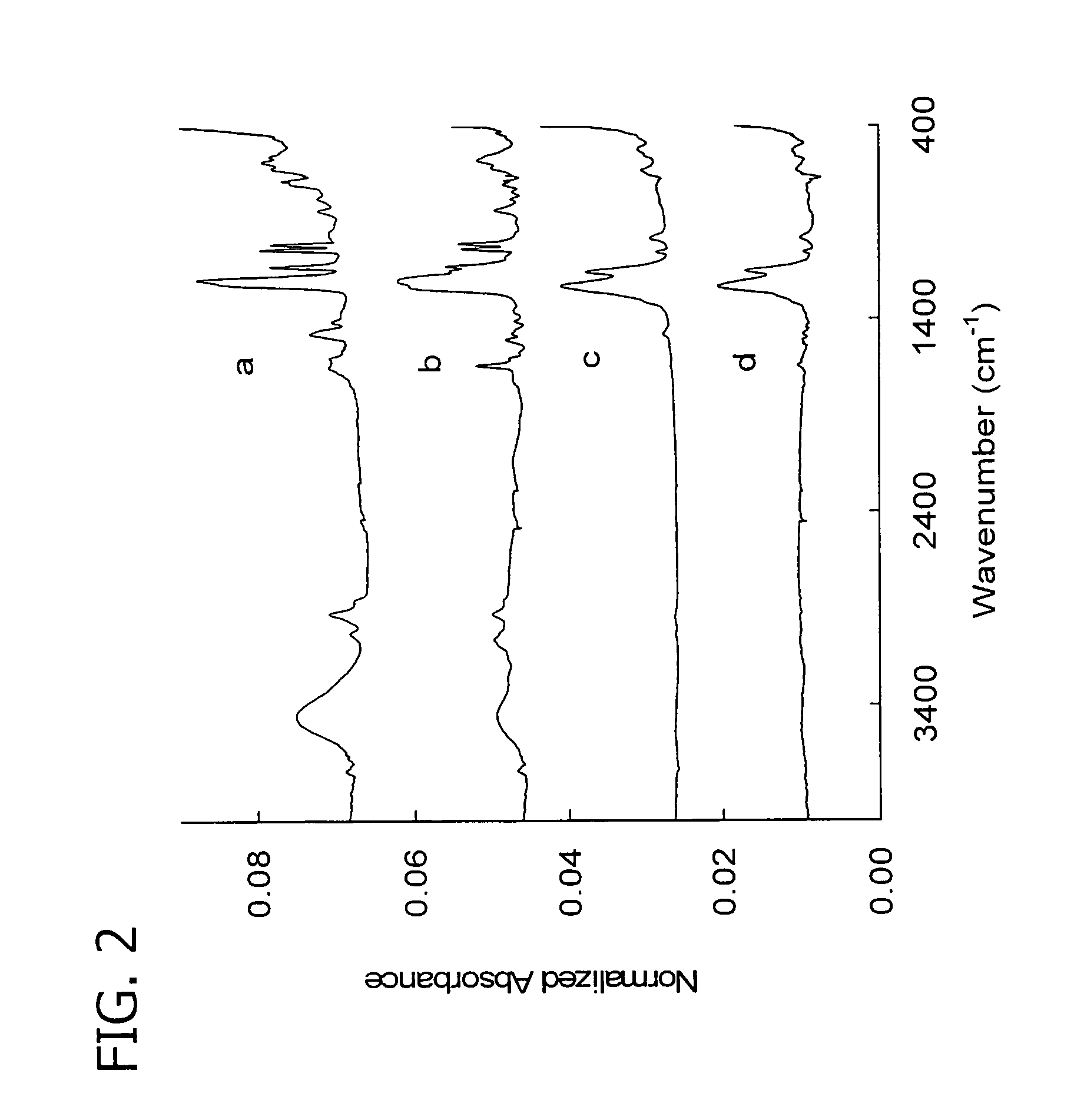Hydrophobic fluorinated polyelectrolyte complex films and associated methods
a fluorinated polyelectrolyte, hydrophobic technology, applied in the direction of basic electric elements, electrical equipment, synthetic resin layered products, etc., can solve the problem of difficult processing of fluorinated polymers into thin films
- Summary
- Abstract
- Description
- Claims
- Application Information
AI Technical Summary
Benefits of technology
Problems solved by technology
Method used
Image
Examples
example 1
Synthesis of Fluorinated Cationic Polyelectrolyte PFPVP
[0124]1,1,1,2,2,3,3,4,4,5,5,6,6-tridecafluoro-8-iodooctane, (TDFI, C8H4F13I) was reacted with poly(4-vinyl pyridine) to give a highly fluorinated polyelectrolyte with novel properties. 1.0 equivalent (1.05 g, 10 mmol) of poly(4-vinylpyridine), P4VP (molecular weight ˜300,000) from Polysciences Inc., was dried at 110° C. for 4 hours. It was then dissolved in a 50 mL 1:1 v / v mixture of dry DMF and nitromethane. At 50° C., under stirring and argon atmosphere, 1.2 equivalents (5.7 g, 12 mmol) of TDFI was injected into the reaction mixture. The reaction proceeded for another 48 hours at 80° C. under stirring and inert atmosphere. The product was precipitated out of solution using ethyl acetate, washed with petroleum ether, filtered, and dried under vacuum for 24 hours at 60° C. The product was characterized by FTIR spectroscopy and extensive alkylation by the fluorinated hydrocarbon was identified by the distinctive C—F stretch in th...
example 2
Layer-by-Layer Buildup of (PFPVP / Nafion) Multilayers
[0126]PEI (Nafion / PFPVP)10 polyelectrolyte multilayers were built on double-side-polished Si [100] wafers using polyethyleneimine (PEI) as the first layer. The polyelectrolytes were 1 mM based on repeat units. Exposure time for polyelectrolytes was 5 minutes with 3 intermediate rinses in methanol for 30 seconds.
[0127]Thickness was measured for every layer using a Gaertner Autogain L116S ellipsometer. The ellipsometer determined both the refractive index and the thickness for multilayers in the 100 nm range, and the refractive index was used for thickness v. layer number measurements. A plot of thickness (A) versus number of layers is shown in FIG. 1. Each layer provides an increment in thickness, showing that thin films of complexed fluorinated polyelectrolytes may be systematically built up.
example 3
Thicknesses and Refractive Indices For Different Polyelectrolyte Combinations
[0128](PDADMA / PSS)10@0.25M NaCl, (PDADMA / Nafion)10, (PFPVP / PSS)10, and (PFPVP / Nafion)10 were built and their thickness and refractive indices were measured using ellipsometry. PEI was not used as initial adhesion layer. The results are reported in Table V. It is seen that PEMUs comprising fluorinated polyelectrolyte have lower refractive indices than PEMUs without fluorinated polyelectrolyte.
[0129]
TABLE VThickness and refractive indices measurements ofdifferent PEMU combinations used in this study.PEMU SystemRefractive IndexThickness (Å)(PDADMA / Nafion)101.35310(PFPVP / PSS)101.49441(PDADMA / PSS)101.56567(PFPVP / Nafion)101.40882
PUM
| Property | Measurement | Unit |
|---|---|---|
| size | aaaaa | aaaaa |
| thickness | aaaaa | aaaaa |
| thick | aaaaa | aaaaa |
Abstract
Description
Claims
Application Information
 Login to View More
Login to View More - R&D
- Intellectual Property
- Life Sciences
- Materials
- Tech Scout
- Unparalleled Data Quality
- Higher Quality Content
- 60% Fewer Hallucinations
Browse by: Latest US Patents, China's latest patents, Technical Efficacy Thesaurus, Application Domain, Technology Topic, Popular Technical Reports.
© 2025 PatSnap. All rights reserved.Legal|Privacy policy|Modern Slavery Act Transparency Statement|Sitemap|About US| Contact US: help@patsnap.com



